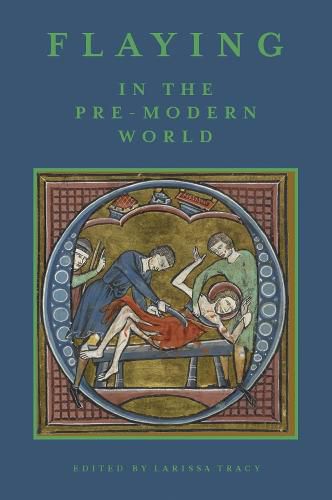Readings Newsletter
Become a Readings Member to make your shopping experience even easier.
Sign in or sign up for free!
You’re not far away from qualifying for FREE standard shipping within Australia
You’ve qualified for FREE standard shipping within Australia
The cart is loading…






Skin is the parchment upon which identity is written; class, race, ethnicity, and gender are all legible upon the human surface. Removing skin tears away identity, and leaves a blank slate upon which law, punishment, sanctity, ormonstrosity can be inscribed; whether as an act of penal brutality, as a comic device, or as a sign of spiritual sacrifice, it leaves a lasting impression about the qualities and nature of humanity. Flaying often functioned as animaginative resource for medieval and early modern artists and writers, even though it seems to have been rarely practiced in reality.
From images of Saint Bartholomew holding his skin in his arms, to scenes of execution in Havelok the Dane, to laws that prescribed it as a punishment for treason, this volume explores the idea and the reality of skin removal - flaying - in the Middle Ages. It interrogates the connection between reality and imagination in depictions of literal skin removal, rather than figurative or theoretical interpretations of flaying, and offers a multilayered view of medieval and early modern perceptions of flaying and its representations in Europeanculture. Its two parts consider practice and representation, capturing the evolution of flaying as both an idea and a practice in the premodern world.
Larissa Tracy is Associate Professor, Longwood University.
Contributors: Frederika Bain, Peter Dent, Kelly DeVries, Valerie Gramling, Perry Neil Harrison, Jack Hartnell, Emily Leverett, Michael Livingston, Sherry C.M. Lindquist, Asa Mittman, Mary Rambaran-Olm, William Sayers, Christine Sciacca, Susan Small, Larissa Tracy, Renee Ward
$9.00 standard shipping within Australia
FREE standard shipping within Australia for orders over $100.00
Express & International shipping calculated at checkout
Skin is the parchment upon which identity is written; class, race, ethnicity, and gender are all legible upon the human surface. Removing skin tears away identity, and leaves a blank slate upon which law, punishment, sanctity, ormonstrosity can be inscribed; whether as an act of penal brutality, as a comic device, or as a sign of spiritual sacrifice, it leaves a lasting impression about the qualities and nature of humanity. Flaying often functioned as animaginative resource for medieval and early modern artists and writers, even though it seems to have been rarely practiced in reality.
From images of Saint Bartholomew holding his skin in his arms, to scenes of execution in Havelok the Dane, to laws that prescribed it as a punishment for treason, this volume explores the idea and the reality of skin removal - flaying - in the Middle Ages. It interrogates the connection between reality and imagination in depictions of literal skin removal, rather than figurative or theoretical interpretations of flaying, and offers a multilayered view of medieval and early modern perceptions of flaying and its representations in Europeanculture. Its two parts consider practice and representation, capturing the evolution of flaying as both an idea and a practice in the premodern world.
Larissa Tracy is Associate Professor, Longwood University.
Contributors: Frederika Bain, Peter Dent, Kelly DeVries, Valerie Gramling, Perry Neil Harrison, Jack Hartnell, Emily Leverett, Michael Livingston, Sherry C.M. Lindquist, Asa Mittman, Mary Rambaran-Olm, William Sayers, Christine Sciacca, Susan Small, Larissa Tracy, Renee Ward